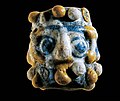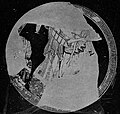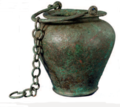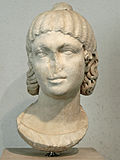Prehistoric Paleolithic finds of lithic industry, Poggio Sommavilla-Grappignano, Tiber Valley
[3] [4] [5] Tomb kit III Necropolis of Poggio Sommavilla, excavations of 1896.
Red-figure chalice krater, sphinx among satyrs dancing and playing the lyre, 5th century. B.C. tomb V necropolis of Poggio Sommavilla, Archaeological Museum of Parma
Archaeological map - Falerii e la sua regione rivelata dai sepolcreti, Mancinelli Scotti Francesco - Biblioteca Comunale Civita Castellana.
Column krater, red-figure pottery, musicians with zither, tomb IV 490-470 BC Poggio Sommavilla necropolis, Harvard Art Museums - Fogg Art Museum - United States of America.
Column krater, red-figure pottery, satyr dances 375-350 BC, tomb 32, Poggio Sommavilla necropolis, SBALazio, southern Etruria.
Kylix with big eyes decorated with a Satyr in the centre, Necropolis of Poggio Sommavilla, Tomb 43.
Decorated aryballos, Etruscan Corinthian pottery, Necropolis of Poggio Sommavilla excavations of 1896, National Museum of Denmark.
Red-figure kylix, Satyr with leopard skin and Thyrsus V a. C. tomb 48, Necropolis of Poggio Sommavilla.
[18] Kantharos with stylized horse engraved on brown body ceramic, excavations of 1896, Necropolis of Poggio Sommavilla.
Red-figure pelike with female figures observing a pomegranate, attributed to the Sommavilla Painter of the 5th century BC. Etruscan Museum "Caludio Faina" Orvieto.
Red-figure kylix, medallion with armed Nero VI BC Tomb II Necropolis of Poggio Sommavilla, Louvre Paris.
Kylix, red-figure ceramic, Leopard Panther, 525-475 BC Poggio Sommavilla necropolis, Musée du Louvre.
Bucchero amphora with reliefs of horses of "Sommavillana" production 6th century BC. C. tomb 32 Necropolis of Poggio Sommavilla.
Red-figure kylix, female male pair 6th BC tomb 48 Necropolis of Poggio Sommavilla, SBALazio Etruria meridionale, Roma.
[19] Tomb kit The Necropolis of Poggio Sommavilla, excavations of 1896
Red-figure craters 5th BC tomb V necropolis of Poggio Sommavilla Archaeological Museum of Parma
Oinochoe with gray body, with equine decorations 6th century. BC Tomb 48, Poggio Sommavilla Necropolis.
Fiaschetta pendaglio amuleto 7th century BC with inscription, necropolis of Poggio Sommavilla, tomb III, side A.
Fiaschetta pendaglio amuleto 7th century BC with inscription, Poggio Sommavilla necropolis, tomb III, profile.
Tomb 14 necropolis of Poggio Sommavilla, section and plan on paper, archivio SBALazio Etruria meridionale.
Inscription in Faliscan language, rock necropolis of Foglia, Tiber Valley
Archaeological map - Falerii e la sua regione rivelata dai sepolcreti, Mancinelli Scotti Francesco - Biblioteca Comunale Civita Castellana.
Falerii e la sua regione rivelata dai sepolcreti, archaeological map by Mancinelli Scotti.
Alabastron with swans, Etruscan Corinthian ceramic Necropolis of Poggio Sommavilla.
Globular aryballos, Etruscan Corinthian ceramic, Poggio Sommavilla necropolis.
Alabastron, Etruscan Corinthian ceramic, running dogs, tomb 27 Poggio Sommavilla necropolis, archivio SBALazio Etruria Meridionale.
Alabastron, Etruscan-Corinthian ceramic motif of running dogs, Poggio Sommavilla necropolis Archaeological Museum Florence.
Alabastron, Etruscan-Corinthian ceramics, Poggio Sommavilla necropolis, Archaeological Museum of Florence.
Glass paste aryballos, Etruscan Museum of Villa Giulia, Rome.
Glass paste necklace, tomb 1, 4th BC Necropolis of Poggio Sommavilla, archivio SBALazio Etruria meridionale.
Kilyx, red-figure pottery 480 BC tomb 39, Poggio Sommavilla necropolis, archivio SBALazio Etruria Meridionale.
Planimetry of tomb 36, Poggio Sommavilla necropolis, archivio SBALazio Etruria Meridionale.
Tomb 36, Poggio Sommavilla necropolis, archivio SBALazio Etruria Meridionale.
Tomb of the ara dei Gelsi, Poggio Sommavilla necropolis, SBALazio Etruria meridionale
[20] Excavations of grave 48, Poggio Sommavilla necropolis, archivio SBALazio Etruria Meridionale.
Lebes Greek ceramic, tomb of the ara dei Gelsi, Poggio Sommavilla necropolis SBALazio etruria meridionale.
Boar-shaped balsam jar, tomb II necropolis of Poggio Sommavilla Archaeological Museum Florence.
Kylix, red-figure ceramic, tomb 2 Poggio Sommavilla necropolis, Florence Archaeological Museum.
Kylix, red-figure ceramic, tomb II necropolis of Poggio Sommavilla, Archaeological Museum of Florence.
Kilyx erotica, medallion, red-figure pottery, 500-450 BC Necropolis of Poggio Sommavilla, Oxford Museum
Attic red-figure kilyx, women with garland and sprig and young people with bags - 490-480
BC. necropolis of Poggio Sommavilla, production: Athens - potter: HIERON EPOIESEN - painter: Makron, Cambridge Museum Oxford
[21] Attic red-figure kilyx, women with garland and sprig and young people with bags - 490-480
BC. necropolis of Poggio Sommavilla, production: Athens - potter: HIERON EPOIESEN - painter: Makron, Cambridge Museum Oxford
[22] Erotic red-figure ceramic kylix, with inscription on the left handle ιερον εποιεσεν, 500-450 BC. Necropolis of Poggio Sommavilla, Oxford Museum
Red-figure ceramic erotic kylix, 500-450 BC Necropolis of Poggio Sommavilla, Oxford Museum
Stamnos by the Sommavilla Painter, red-figure ceramic, naked boys, 5th BC Necropolis of Genoa, Civic Archaeological Museum Genoa Pegli.
Sun rises between six satyrs, drawing of the decoration of a red-figure ceramic krater 380-360 BC. Necropolis of Poggio Sommavilla, Archaeological Museum of Parma.
Olla from the fantastic bestiary, excision of fantastic animals, tomb II VI BC necropolis of Poggio Sommavilla, archivio SBALazio Museo Civico Rieti.
Bronze elements, Poggio Sommavilla necropolis archivio SBALazio etruria meridionale.
Bronze situla VI V BC tomb 32, Poggio Sommavilla necropolis archivio SBLazio etruria meridionale
Amphora with decoration impressed on small cylinders, locally produced, tomb in the Poggio Sommavilla necropolis Archivio Soprintendenza Archeologia del Lazio e dell'Etruria Meridionale
Memorial stone of African freedom, of the Pacci, courtyard of the Cicignano crossroads building and the local historian avv. Umberto Mattei
[23] [24] Roman inscription in the courtyard of the Cicignano crossroads block
[23] [24] Toccia
[25] ruins, arched door on the tuff spur, area of the archaic Votive Well, Ponte del Peccato, valley of the Aia stream, Grappignano Poggio Sommavilla.
[26] [27] Grappignano, archaeological area
Ancient roads, aerial bombing of RAF Grappignano
[28] Marble bas-relief of a plumed helmet, Casone Collevecchio, provenance of the Colli monument
[29] Torre Romana
[30] [31] [32] [33] with construction of a severed boundary, Colli road Fosso del Barcone,
[34] Madonna del Piano fountain, valley of the Aia stream, Collevecchio-Poggio Sommavilla
VICCIANA tile stamp. DF. STATONIE. common Roman burial ground of the freedman Satrino, station road. of Poggio Sommavilla, preserved in the Municipality of Collevecchio
[35] Statue of Tranquillina,
[36] tfound by a farmer near the locality known as the
dei Frati north of the current historic center of Poggio Sommavilla
[37] [38] Castri Summa Villa Chronicon 33 di
Benedetto del Soratte p.
46
[39] Basements (Basolati) on a floodplain embankment of the Tiber, Campo Rampone, Poggio Sommavilla archaeological area, Tiber Valley
Poggio Sommavilla Poggetto, current historical center, archaeological area






































































